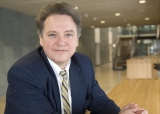Professor Kenneth A. Dawson
The PhysOrg article Scientists form alliance to develop nanotoxicology protocols said
A team of materials scientists and toxicologists announced the formation of a new international research alliance to establish protocols for reproducible toxicological testing of nanomaterials in both cultured cells and animals. The International Alliance for NanoEHS Harmonization (IANH) was unveiled today at Nanotox 2008, one of the world’s largest biennial nanotoxicological research meetings.
“When this team of scientists from Europe, the U.S., and Japan are able to get the same results for interactions of nanomaterials with biological organisms, then science and society can have higher confidence in the safety of these materials,” said Kenneth Dawson, of University College Dublin and current chair of the IANH team.
Kenneth A. Dawson, BSc, MSc, D.Phil is
Director of Center for Bionano Interactions and
Chair of Physical Chemistry
within the UCD School of Chemistry and Chemical Biology,
Ireland.
An
experienced
and multi-award-winning researcher, his focus is on groundbreaking
projects that are exploring the nature of the interaction between
nanoscale structures and living matter, such as cells and tissue.
Kenneth’s research interests include:
BioNano Interactions
Development of a rational basis for investigating and understanding how
nanomaterials interact within living systems (cells, tissues, organisms,
humans) is a fundamental challenge. Understanding the
mechanisms and spatiotemporal aspects of nanomaterial interactions with
living systems will enable him to design new nano-based therapies and
diagnostic platforms, as well as ensuring that nanomaterials not
intended for human contact can be utilized safely.
By
combining physical
chemical approaches with state of the art biological technologies he is
framing and developing quantitative bionanoscience. Ongoing projects
include development of a kinetic model of nanoparticle uptake by cells;
elucidation of the portals and mechanisms of nanoparticle uptake by
various cells; development of a human blood-brain barrier co-culture
model; and mapping of the spatio-temporal pathways utilized by
nanoparticles in cells.
Protein-Nanoparticle Interactions
Living systems never contact bare nanoparticle surfaces — rather
they are
coated by a dynamic and evolving layer of proteins, lipids, and other
biomolecules immediately upon contact with living systems.
Much of his
current work is directed to understanding the details of these evolving
biomolecule coronas — identifying the proteins involved and how
these
evolve as the nanoparticles are trafficked in cells; connecting this to
potential functional impacts in terms of changes in the protein
conformation and protein misfolding events; development of new
approaches to map the outer layers of the biomolecule corona which
interact with the cellular machinery; and understanding the rules
governing nanoparticle-protein interaction.
Quantitative BioNanoInteraction
He seeks to catalyze the emergence of a new quantitative approach to
understanding how nanoscale objects interact with living matter. Thus,
he develops novel labeled nanoparticles applying imaging and related
techniques to follow them entering and moving within
cells.
These
measurements he seeks to make reproducible and quantitative and this
leads him to push typical methods of cell culture, cell biology,
nanoparticle dispersion technology, and related elements to a level far
beyond the usual requirements. In particular he can now reproducibly
follow several classes of nanoparticles into cells lines, with
reproducibility and precision more familiar in physical sciences.
Systems Approaches
Here he applies the methods of simulation, modeling, theory, and
mathematical approaches to understanding issues of dynamical arrest,
correlations between events, and to developing quantitative
understanding
of nanoparticle impacts on living systems.
Projects
include development
of a framework for understanding relationship between gene expression
profiles and cancer onset; understanding slowed dynamics and more
recently its application to intracellular processing and trafficking
intermittancy events, which are likely to have very significant impact
for biological systems.
New Responsive and Smart Delivery Nanoparticles
Polymeric nanoparticles can be loaded with therapeutic agents and
tailored to adsorb specific proteins and thereby to target specific
cellular trafficking pathways and reach specific sub-cellular locations
is the dream of nanomedicine. In this arena, he is working on
development of such particles, tailoring the particle size, surface
hydrophobicity, surface charge, surface ligands, and loading strategies
to design smart delivery systems that can go with very high selectivity
to target organs / tissues / sub-cellular organelles.
Kenneth authored
The glass paradigm for colloidal glasses, gels, and other
arrested states driven by attractive interactions
and coauthored
Phase equilibria and glass transition in colloidal systems with
short-ranged
attractive interactions. Application to protein crystallization,
Universality in Lattice Models of Dynamic Arrest: Introduction of an
Order Parameter,
Interaction of soft condensed materials with living
cells: Phenotypesranscriptome correlations for
the hydrophobic effect,
Clarification of the Bootstrap Percolation Paradox,
The nature of the colloidal “glass” transition, and
Phase Behavior of DPPC in a DNA-Calcium-Zwitterionic
Lipid Complex Studied by Small-Angle X-ray Scattering.
Kenneth earned his B.Sc. in Chemistry at
Queen’s University Belfast (QUB) in 1980. He earned his
M.Sc. in Mathematics at QUB in 1981, and he earned his D. Phil in
Theoretical Chemistry at the University of Oxford in 1984.
Watch
Nanoscience… the next frontier.
Read
Nanoparticles: size and charge matter.





